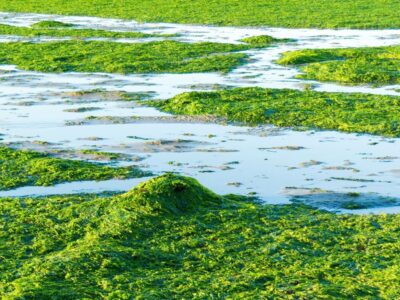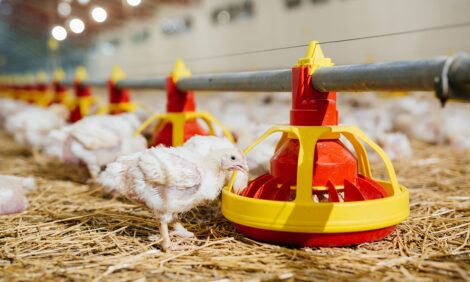



A conversation with Ocean Harvest Technology CEO Mark Williams
For more than a decade, Ocean Harvest Technology has been researching and learning about the specific benefits that its seaweed blend products can generateEditor's note: I recently spoke to Ocean Harvest Technology CEO Mark Williams about their growing business, their OceanFeed product and what makes it unique. The UK-based company harvests seaweed from around the world and processes it in Vietnam. They offer a global sales footprint with prebiotic products for the livestock, aquaculture and companion animal sectors.
Tell me about Ocean Harvest Technology.

Ocean Harvest Technology (OHT) is a leading supplier of seaweed-derived prebiotics to the global animal feed industry. Headquartered and listed on the stock exchange in the UK, with a GMP+ accredited manufacturing facility in Vietnam, OHT operates a global supply chain to source the most suitable seaweeds for use in animal nutrition. These seaweeds are selected for the functional effects of their polysaccharide components and have been scientifically proven across numerous research trials to deliver benefits in gut health and animal performance.
OceanFeed™ Poultry – What is it?
OceanFeed Poultry (OFP) is a specifically formulated blend of whole seaweed meals, designed to support poultry gut health, immune function and performance. The main mode of action of the product is through the prebiotic effects of the soluble fiber (polysaccharides) component of the seaweeds. Research trials have demonstrated significant improvements in the abundance and diversity of two of the main butyrate producing species of bacteria in the ceca of chicken supplemented with OFP, with subsequent benefits for bird performance. Additional in vitro trials have also confirmed anti-inflammatory and pathogen agglomerating effects of the seaweed blend, highlighting the benefits of utilising whole seaweed meals to capture the wide range of bioactivity from other functional components of seaweeds such as phlorotannins, flavonoids and pigments.

What makes OceanFeed Poultry unique?
There are a number of different features of OFP that help it to stand out from other similar products available to feed producers. For a start, there are very few seaweed-based prebiotics available at significant commercial scale, and to our knowledge, none that utilize blends of whole seaweeds. The blended aspect is important, as it provides a balanced range of fiber substrates for fermentation by the butyrate producers in the ceca. As mentioned above, using whole seaweeds (as opposed to polysaccharide extracts) also enables producers to benefit from the wide range of bioactive compounds, in addition to the prebiotic effects. When comparing seaweed-based prebiotics to those derived from terrestrial plants, both the soluble and the sulfated nature of the seaweed fibers are key differentiating factors to consider. The high proportion of soluble fiber in seaweed enhances their availability for fermentation, hence the strong effects we have demonstrated on the abundance and diversity of beneficial gut bacteria. Sulfated polysaccharides are also unique to seaweeds, and reports in general scientific literature indicate their strong anti-microbial, anti-inflammatory and antioxidant properties.
What results should poultry operations expect?
The beneficial effects of OFP on the gut microbiome described above are reflected in improvements in a number of different performance metrics, depending on the application (broilers or layers) and health status of the flock. Increases in litter dry matter are to be expected in all cases, and we typically see improvements in feed efficiency of approximately 5%. Trials we have done with layers have demonstrated improvements in egg production, egg quality (Haugh units) and stronger egg shells. In our broiler trials, we have shown improvements in daily gain alongside efficiency gains and improvements in breast meat yield and mortality reductions. In our most recent work in broilers, OFP supplementation reduced mortality by 33% in a necrotic enteritis challenge study. The improvements in production and efficiency in both broilers and layers have delivered increased income over feed costs and reductions in feeding costs, with OFP typically providing a return on investment of between 4 and 5:1.
Who is OceanFeed Poultry designed for?
OceanFeed Poultry is designed for poultry farmers and producers who are looking for a cost effective, natural and sustainable feed additive to enhance the performance and health of their flock. The use of low carbon, marine-derived ingredients aligns with the growing demand for sustainable solutions in animal feed. OceanFeed Poultry is also a great option for producers looking to move away from in-feed antibiotics, as trials have demonstrated OFP can be used in antibiotic growth promoter-free poultry diets.
How is OceanFeed used globally?
In regions that have operated without antibiotics for a number of years, OFP is often used at inclusion rates of 1.25 kg/tonne, and in many cases is used to replace other gut health additives such as prebiotics, probiotics, phytogenics and yeast extracts. In markets where in-feed antibiotics are still used, customers are using OFP as a replacement for these antibiotic growth promoters, typically at 2.5 kg/tonne inclusion rates. In challenge scenarios such as the necrotic enteritis trial described above, best results are seen with higher inclusion rates of up to 5 kg/t. The product is heat stable for use in extruded feeds and can be provided in crumble and powder forms to suit each customer, depending on how they wish to incorporate OFP into their rations.
Learn more about Ocean Harvest Technology and OceanFeed Poultry. Or stop by Booth # A447 at IPPE in Atlanta, Georgia to speak to the Ocean Harvest Technology team.









